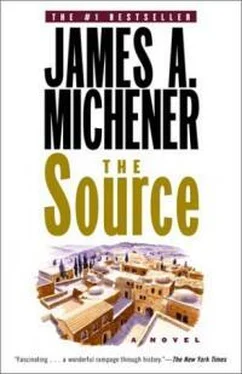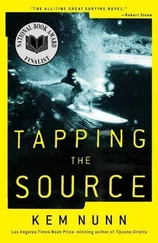Her words soft and reasonable, her voice low and comforting had an almost frightening effect on Hoopoe, for he understood exactly what they meant, and for a fleeting moment he was prepared to sit down with her now and to speak frankly of all problems confronting them; but so many significant ideas were involved that he shied away. He loved Kerith too much to disturb her before his plans were formulated, so he finished his sweet wine and carried a roll of scraped leather into another room, where he stayed up late drawing rough sketches of his scheme to save Makor, and in the morning, after he had started his slaves upon their work, he reported to the governor’s office, where he told that official, “Sir, now that the wall is completed I grow more worried about our water supply.”
“I asked you to mend the waterwall,” the governor said. “I inspected it the other day and your Moabite did an excellent job on the repairs.”
“Sir! It fools no one. Fifty Phoenicians could knock it down.”
“Last time they overlooked it.”
“Next time they won’t.”
“What do you want to do?” the governor asked. “Have your slaves build a new set of walls?”
“I have a much different plan,” Hoopoe said.
The governor laughed. Placing his hand on the shoulder of the fat builder he said condescendingly, “I understand your problem, Hoopoe. You’ve finished the town walls and you’re afraid that if you don’t start something right now Jerusalem will take away your slaves. Isn’t that it?”
“I’m concerned not about slaves but about the safety of my town.” He corrected himself. “Your town.”
The little man had spoken with such gravity that the governor had to listen. “Well, what is it?”
Hoopoe gulped from nervousness and made the first formal presentation of his daring scheme. Using his hands as great shovels he said, “Here in the center of town, inside the walls, we must dig a shaft almost as big as this room straight down through rubble and solid rock for ninety cubits.” The governor gasped. “At the bottom we begin to dig a tunnel that will take us far under the town walls and out to the well.”
“How long a tunnel?”
“Nearly two hundred cubits, and high enough for women to walk in. Then we bury the well under mound after mound of rock, and we are secure from any besieger.” He moved his right hand back and forth to indicate women walking in safety through the subterranean passageway.
To the governor the concept was so fantastic that he could only laugh. He was unable to visualize a hole almost as big as his room, sinking so far into the earth; and as for the idea of a tunnel burrowing through solid rock and somehow striking the well, he knew this to be folly. “Hoopoe, we need no more digging around here,” he told his engineer. “Get yourself a farm outside the wall and dig for worms.” His joke appealed to him, so he bobbed his head up and down like a hoopoe bird and added, “For worms! You understand?”
Hoopoe hid his resentment. “On one point you’re right, sir. We should start this before they take away our slaves.”
“See! I knew that’s what worried you.”
“It does. We have a trained team now. The Moabite is the best foreman we’ve ever had in Makor, and the others make a fine unit.”
“I’m sure Jerusalem will take the slaves,” the governor said. Showing his engineer to the door he bobbed his head up and down several times. “You go dig worms.” And he closed the door on the preposterous idea of digging a hole through the heart of the town.
Hoopoe did not go to the workings but wandered home, where he laid before Kerith his intricate plan: shaft, tunnel, burial of the well; and she irritated him by saying that she was sure the plan wouldn’t work. “How could anyone start from the bottom of a shaft, dig a sloping tunnel, and hope to find a thing as small as a well?”
“That’s my job.”
She laughed. “How will you see underground? Like a mole?”
He was weary from trying to explain ideas to people who could not visualize them, so he kissed his wife good-bye and climbed onto the ramparts back of his home; and the mound on which Makor stood had now grown so high that from the walls Hoopoe could look westward and see Aecho, where Phoenician ships from many ports brought the men and the riches which would one day be thrown against Makor. How far away the tempting city looked to one who had seen it only as a boy; how close it seemed to a man who understood the power and cupidity of the Phoenicians.
In deepening gloom he walked along the ramparts to the north edge of town, where he studied the doomed waterwall as it left the postern gate and ran to the well, but he did not spend much time worrying about that obsolete system which had rarely impeded a determined adversary. He looked instead down into the wadi and up the opposite slopes until he reached a point on the mountainside above which stood the monolith to Baal. He satisfied himself that on the mountain he could reach the point he sought. “I know it’s possible,” he growled. And then he looked again at the waterwall, and in its place he visualized the combination of shaft and tunnel that would comprise his system. Imagining it to be already in operation, he looked westward at Aecho and thought: When the Phoenicians do strike at us again they will find no well to attack.
But for some weeks it looked as if there would be no system of tunnels, for when Hoopoe returned to the governor’s office, fortified with new enthusiasm, he accomplished nothing. The governor had won Jerusalem’s respect by sending surplus income to the capital rather than asking for assistance, and he had no intention of reversing this process. He would not divert Makor’s wealth into a bunch of hoopoe holes struck here and there in the ground. “If I took this plan to Jerusalem,” he predicted, “they’d hoot me out of the capital.”
Hoopoe became angry. “How could you take the plan to Jerusalem? You don’t know what it is.”
“I can recognize waste without seeing plans,” the governor replied, and a servant showed the engineer to the door.
In order not to lose his well-co-ordinated team of slaves, Hoopoe put them to work resurfacing the temple square. When this was done he started them on two additional silos for wheat storage, and as the slaves dug deep into the earth of Makor, waterproofing the sides with lime plaster to keep out insects and seepage, he often climbed inside to inspect the work; and when his round face and black beard appeared at the openings as he came back out, townspeople would cry, “What you looking for, Hoopoe? Worms?”
But in the evenings, when his slaves were dismissed, Hoopoe used to go to the northern wall and continue the calculations that would form the basis of his work if the water system were ever authorized. Judging from the relative terrains he deduced that he would have to sink his main shaft from a point inside the postern gate through some forty feet of rubble that comprised the mound, then ninety feet below that through solid rock, at which level he would begin his sloping tunnel, which would run for a distance of about two hundred and eighty feet to the well. The finished system would thus require about four hundred and ten feet of boring, mostly through solid rock. “But in the end we’d have a system that no enemy could touch.” He could see women walking down the stairs of the shaft, bearing empty water jars on their heads, then reaching the tunnel and walking along an easy slope to the buried well, impervious to enemies that might rage above. Even to the imagination Hoopoe’s system imparted a sense of security, so one evening toward the end of Abib he finished his master drawing on the leather and began scratching working details onto a set of small clay tablets.
Читать дальше








![Джеймс Купер - Пионеры, или У истоков Саскуиханны [The Pioneers, or The sources of the Susquehannah]](/books/395797/dzhejms-kuper-pionery-ili-u-istokov-saskuihanny-t-thumb.webp)

